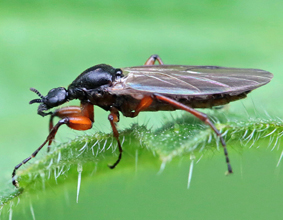Les Bibionidae (Diptera) de la tourbière de Machais (France, Grand Est, Vosges)
 Extended abstract - Bibionidae are a small family of robust flies (3–15 mm) showing strong sexual dimorphism, especially in coloration and head morphology. In Europe, most species are recognizable by the ornamentation of the fore tibiae, either with apical spurs (Bibio) or with rows of spines (Dilophus). Adults, often visiting flowers, are regarded as important pollinators, while larvae are gregarious soil-dwellers, feeding on decaying organic matter. About 45 species occur in Europe, 24 of which are known from mainland France. Some are widespread, while others are restricted to mountain or Mediterranean habitats.
Extended abstract - Bibionidae are a small family of robust flies (3–15 mm) showing strong sexual dimorphism, especially in coloration and head morphology. In Europe, most species are recognizable by the ornamentation of the fore tibiae, either with apical spurs (Bibio) or with rows of spines (Dilophus). Adults, often visiting flowers, are regarded as important pollinators, while larvae are gregarious soil-dwellers, feeding on decaying organic matter. About 45 species occur in Europe, 24 of which are known from mainland France. Some are widespread, while others are restricted to mountain or Mediterranean habitats.
The Bibionidae of the Vosges had received little attention, with only two species previously mentioned in the literature. The large-scale entomological survey of the 'tourbière de Machais' National Nature Reserve conducted in 2009, 2020, and 2021 provided the first opportunity to document the diversity of this family in the area. Sampling relied on passive Malaise traps placed in a range of habitats, including montane beech forests, oligotrophic wet meadows, and transition bogs. All material is preserved in the collections of the Natural History Museum of Neuchâtel.
A total of 387 specimens, belonging to 10 species, were captured. Bibio varipes was by far the most abundant, representing almost two-thirds of all individuals, followed by B. johannis, B. lanigerus, B. marci, and Dilophus neglectus, each contributing 8–11% of the catch. Three species, B. nigriventris, B. pomonae, and D. neglectus, are primarily associated with montane environments, while the remaining species are widespread across France and Europe. Species composition was consistent between 2020 and 2021, and traps located at the forest–bog interface accounted for the majority of captures. The overall sex ratio was strongly biased toward females (86%), likely due to the trapping method, as males are more often caught during swarm flights.
The most remarkable result is the first record of Dilophus neglectus Haenni, 1982, from the Vosges. This montane species, previously known only from a few French localities (Jura, Massif Central, and recently the southern Alps), typically occurs between 800 and 2 000 m in Central Europe. Earlier records from the Pyrenees are now attributed to an undescribed related species.
The Bibionidae fauna of the Vosges now comprises ten species, four of which (B. johannis, B. leucopterus, B. nigriventris, and D. neglectus) are newly recorded. These results confirm the presence of common and widespread taxa, but also highlight the occurrence of montane elements of biogeographical interest. The inventory emphasizes both the importance of the Machais peat-bog as a refuge for insect diversity and the still fragmentary knowledge of Bibionidae in France. Additional surveys in similar habitats will likely reveal further species, especially within Dilophus.
Keywords – Bibionidae, Diptera, entomofauna, faunistics, montain species, peat-bog, Vosges, biodiversity inventory.
Haenni J.-P. 2025. Les Bibionidae (Diptera) de la tourbière de Machais (France, Grand Est, Vosges). Bulletin de la Société d'Histoire naturelle et d'Ethnographie de Colmar, 82 (14) : 97-100. https://doi.org/10.5281/zenodo.17104386
